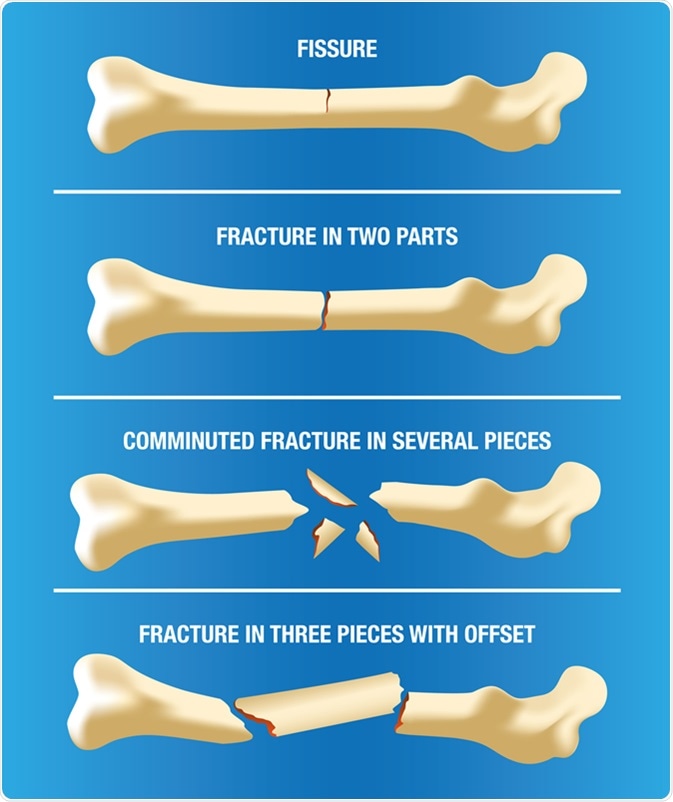A broken bone or a fracture is a very painful injury. Immediate first aid is crucial for broken bones. Moving the injured bones may increase pain and bleeding. Also, it may lead to tissue damage.
What is a Fracture or Broken Bone?
A broken bone or bone fracture happens when a force applied to a bone is stronger than it can bear. As a result, it disturbs the structure and strength of the bone. It leads to pain, swelling, and loss of function.

Illustration of a bone skeleton illustrating various types of fractures. Image Credit: Luciano Cosmo / Shutterstock
Types of Fractures
There are several types of fractures, namely, simple, compound, complete, and incomplete.
In a simple fracture, the bone breaks but the broken edges do not push through the skin. When a compound fracture occurs, however, the bone breaks through the skin, through an existing open wound or creating one.
A fracture is classified as complete or incomplete depending on the manner in which the fracture occurs. In a complete fracture, the bone breaks into two separate pieces. On the other hand, in an incomplete fracture, the bone just cracks but the pieces are not separated throughout the width of the bone.
Causes of Fracture
A broken bone or fracture occurs when an external force is exerted upon the bone from a fall or blow. If the bone cannot withstand the amount of force applied, it breaks. It is essential to know that a bone crack or break, all describe the same kind of situation.
The most common causes of broken bones include trauma such as occurs with a vehicular accident or fall, overuse due to repetitive motion and stress fractures, and osteoporosis, a condition that weakens the bones and makes them prone to fractures.
Fractures due to osteoporosis are also a serious concern. They pose a significant economic burden and have a negative impact on the health and well-being of the patient.
Osteoporosis causes more than 8.9 million fractures each year across the globe. In other words, there is an osteoporotic fracture every three seconds.
Signs and Symptoms of a Broken Bone
The most common signs and symptoms of a broken bone include:
- Bruising or swelling over the injured bone
- Pain in the injured area that becomes worse when the part is moved
- Deformity of an arm or leg
- Loss of function
Broken Bones: What to do
If you suspect a person has a broken bone or fracture, provide first-aid treatment.
The most important thing to remember is never to move a patient with a suspected fracture. This may cause severe pain and may worsen the injury.
Reassure the patient and encourage relaxation by being calm and providing assurance of immediate help. Call for an ambulance or medical assistance.
Assess the patient rapidly for any signs of deformity, open injuries, tenderness, and swelling. Also, check for the inability to move the injured area or any sign of bleeding.
When there is bleeding, apply pressure on the wound to prevent blood loss.
Then apply the RICE method:
- R – REST - Have the patient rest the affected area and prevent any movement to reduce pain. Support the fractured part or encourage the patient to support it.
- I – IMMOBILIZE – Immobilize or stabilize the injured area on the ground. If movement is needed, apply splints on either side of the injured part for stability. Broad bandages are useful in preventing joint movement on either side of the break in the bone. Splints should always be padded, and any space in between the body and the splint must be filled in gently with more padding to keep it from moving. Secure the splint properly. If the foot is suspected to be fractured, the foot and ankle must be immobilized. Make sure the bandages are not too loose or too tight and repeat this check about every 15 minutes. Make
- C – COLD – If available, apply a cold pack, ice, or cold water in a plastic bag to the injured area. Remember to put a folded gauze pad or cloth between the ice pack and the skin to prevent skin damage. Leave the ice pack on for about 20 minutes. Do not apply the cold compress directly on an open fracture.
- E – ELEVATE – Always elevate the injured part above the heart level, if it’s possible. However, do not elevate it if you suspect a broken bone or if moving the area will cause pain.
- If you suspect a fracture, you can apply splints. Use paddings between the body part and the splint. Make sure the circulation is not cut off.
- You can apply an arm sling if the injured part is the upper limb.
If the person doesn’t appear to be breathing or has become unconscious, begin cardiopulmonary resuscitation. Remember, call for medical help if:
- you suspect the fracture is in the patient’s back, neck, or head
- the fractured bone has pushed through the skin
- there is heavy bleeding
Regardless of which part of the body is affected by a fractured bone, it is vital to call an ambulance or medical help. A broken bone may lead to many complications, some of which are potentially life-threatening.
Further Reading